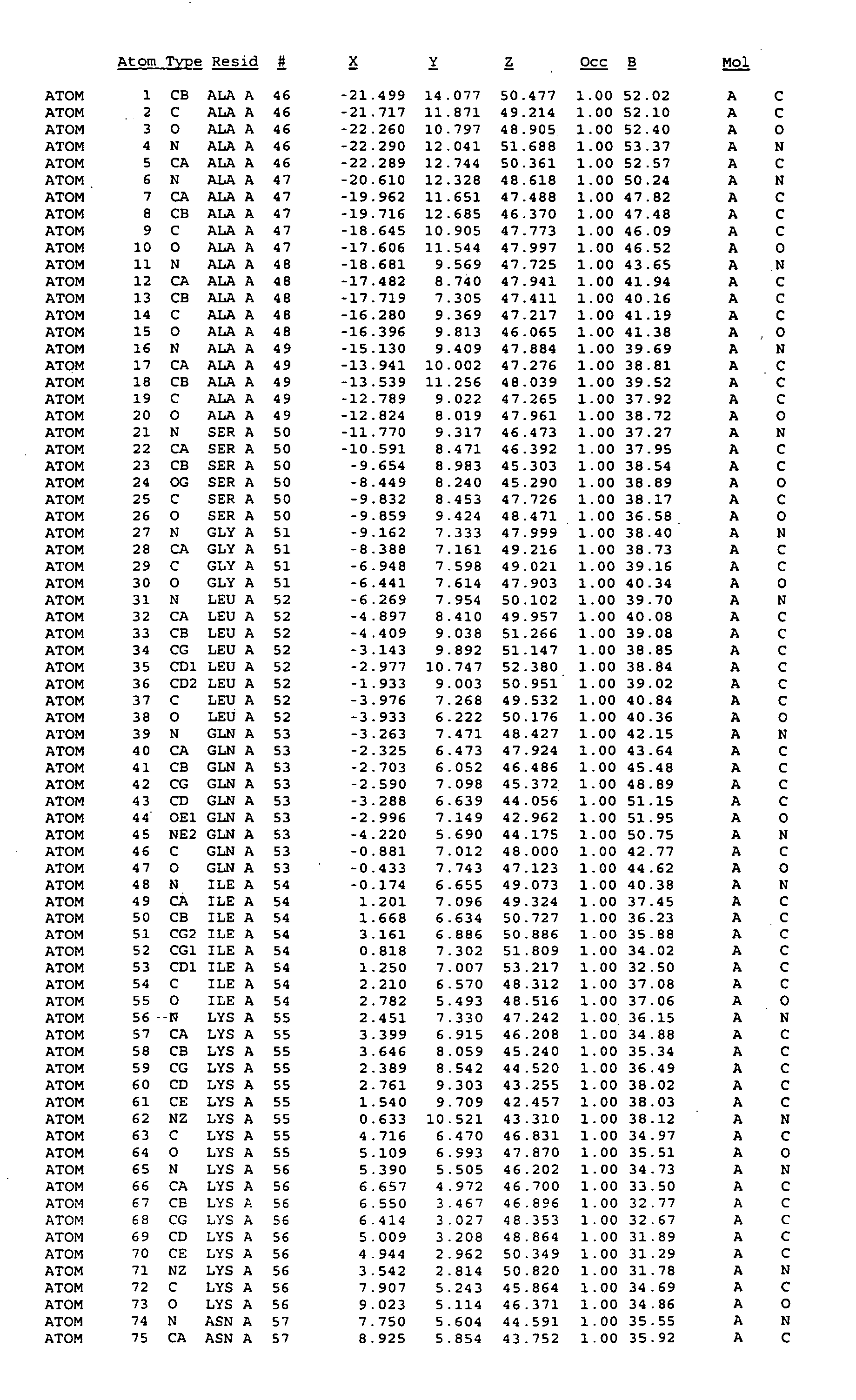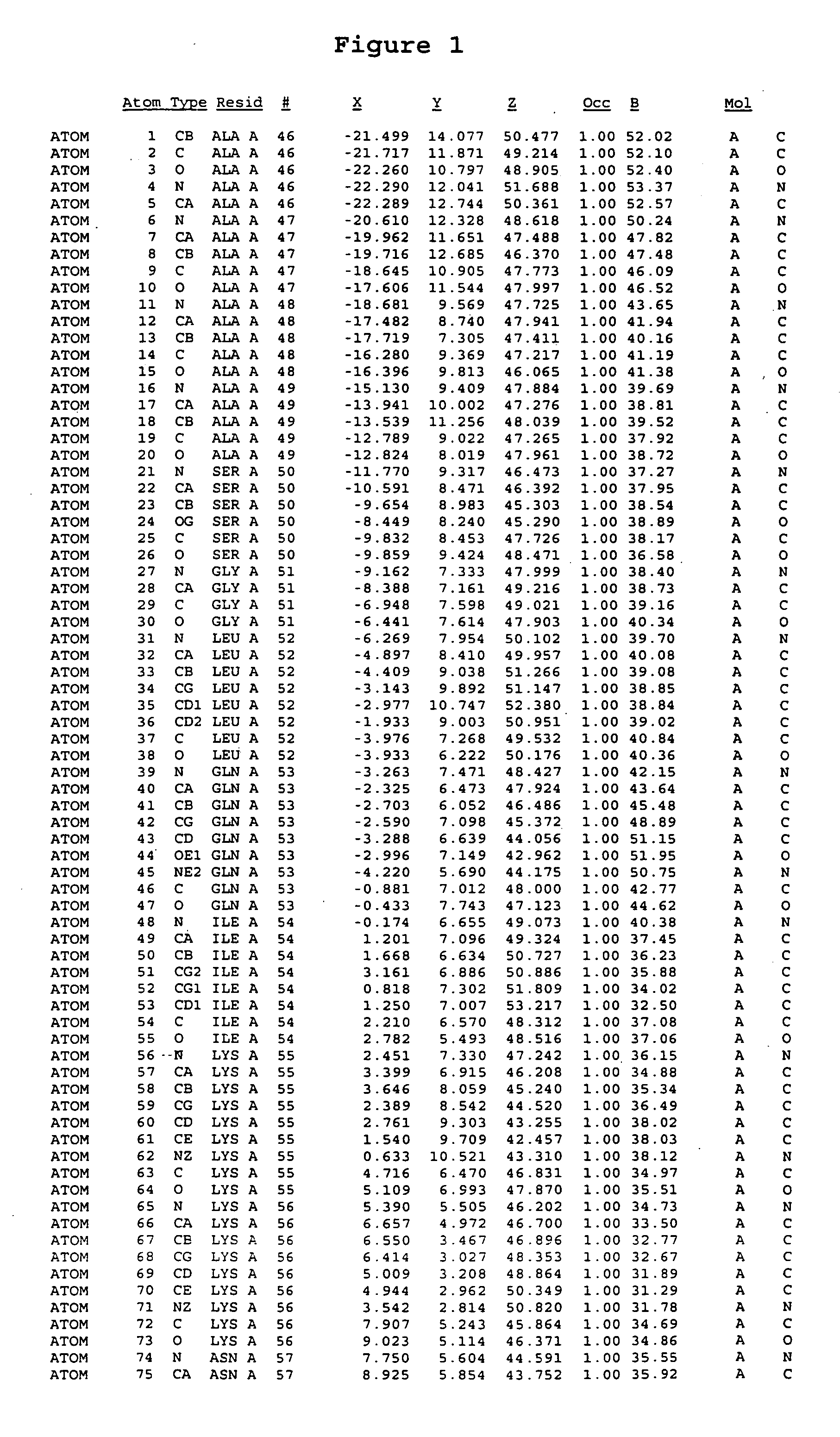Crystal structure of mitogen-activated protein kinase-activated protein kinase 2 and binding pockets thereof
a technology of mitogen-activated protein and crystal structure, which is applied in the field of crystal structure of mitogen-activated protein kinase-activated protein kinase 2 and the binding pocket thereof, can solve the problems of non-selective inhibitors causing unwanted side effects and no one has described x-ray crystal structure coordinate information
- Summary
- Abstract
- Description
- Claims
- Application Information
AI Technical Summary
Benefits of technology
Problems solved by technology
Method used
Image
Examples
example 1
Expression of MAPKAPK2
[0227] The expression of human MAPKAPK2 was carried out using standard procedures known in the art. Specifically, MAPKAPK2 residues 47-400 were cloned into pBEV1, a T7 polymerase based E. coli expression vector. BL21(DE3) competent cells were then transformed with pBEV1 / (HIS)6-tag (SEQ ID NO: 5) MAPKAPK2(47-400) via a standard transformation protocol.
[0228] The freshly transformed cells were grown at 37° C., for 16 hours, in a complex media supplemented with 100 μg / ml carbenicillin. This culture was used to inoculate additional flasks of M9 / carbenicillin(1:10). These cultures were then grown to OD600 0.7-0.9, whereupon amino acids lysine, phenylalanine, and threonine were added to final concentrations of 100 mg / L; amino acids seleno-methionine, isoleucine, and valine were added to final concentrations of 50 mg / L. The growth temperature was then reduced to 30° C. After 30 minutes, induction was initiated by the addition of 1 mM IPTG. The cells were then harves...
example 2
Purification of MAPKAPK2
[0229] The frozen cell paste from Example 1 was thawed in 10 volumes of Buffer A (50 mM HEPES, pH 7.8, 10% glycerol, 2 mM β-mercaptoethanol, 200 mM NaCl, 0.02% Tween 20)+0.5 mM Pefabloc, 2 μg / ml pepstatin, 1 g / ml E64, 1 μg / ml leupeptin and lysed in a microfluidizer. The lysate was centrifuged at 54,000 g for 1 hour. The supernatant was collected and incubated batchwise with Talon metal affinity resin. After extensive washing with Buffer A, the resin was eluted with Buffer A+150 mM imidazole. One unit of thrombin per mg of His-tagged protein was added to the Talon elute pool and allowed to incubate at room temperature for 1 hour. The thrombin activity was quenched by addition of 0.5 mM pefabloc. The protein was diluted 1:4 to lower the NaCl to 50 mM, and loaded onto a Q-sepharose column pre-equilibrated with Buffer A. The flow-through fractions, containing MAPKAPK2, were collected and directly loaded to a SP-sepharose column pre-equilibrated with Buffer B (25...
example 3
Crystallization of MAPKAPK2
[0230] Crystals grew by equilibrating a drop containing 10 mg / ml protein solution and equal volume of reservoir solution (2 M of Na / K phosphate at pH 5.15) against the reservoir. Larger crystals were obtained by multi-step seeding, as small seeding crystals were transferred into drops containing protein and precipitant. Most crystals could only be processed in P1 space group with six molecules in an asymmetrical unit. One crystal, which was soaked in Methyl mercury nitrate for overnight was of the space group R3. Once the crystals were harvested, they were transferred to reservoir solutions containing increasing concentrations of glycerol, starting with 5% and increasing to 10, 15, 20, 25 and 30%. After soaking the crystals in 30% glycerol for less than 5 minutes, the crystals were scooped up with a cryo-loop, frozen in liquid nitrogen and stored for data collection.
PUM
| Property | Measurement | Unit |
|---|---|---|
| concentrations | aaaaa | aaaaa |
| concentrations | aaaaa | aaaaa |
| temperature | aaaaa | aaaaa |
Abstract
Description
Claims
Application Information
 Login to View More
Login to View More - R&D
- Intellectual Property
- Life Sciences
- Materials
- Tech Scout
- Unparalleled Data Quality
- Higher Quality Content
- 60% Fewer Hallucinations
Browse by: Latest US Patents, China's latest patents, Technical Efficacy Thesaurus, Application Domain, Technology Topic, Popular Technical Reports.
© 2025 PatSnap. All rights reserved.Legal|Privacy policy|Modern Slavery Act Transparency Statement|Sitemap|About US| Contact US: help@patsnap.com



